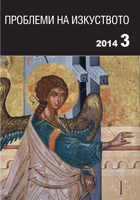За украсата в стил in negativо и неговите модификации в гръцките ръкописи от ХІV век (Cod. D. Gr. 260 от колекцията на ЦСВ П „Проф. И. Дуйчев”)
On the In Negativo Style Decoration and its Variations in the Greek 14th Century Manuscripts (Cod. D. 260 from the Collection of the Ivan Duichev...
Author(s): Ivaila BogdanovaSubject(s): Cultural history
Published by: Институт за изследване на изкуствата, Българска академия на науките
Summary/Abstract: On the In Negativo Style Decoration and its Variations in the Greek 14th Century Manuscripts (Cod. D. 260 from the Collection of the Ivan Duichev Center) The in negativo or carmine style, as named by Cavallo, is widely used in the Byzantine illuminated manuscripts both in its classical form and in various modifications. The decoration of the XIV C. Four Gospels Cod. D. gr. 260 from the collection of the Ivan Duichev Center is an example of stylistic interpretation of the Byzantine ornament in in negativo style. The colors used for the decoration are carmine red and yellow. Although the paint was applied very diluted, and not with the typical for the classical form of the carmine style intensity, the decoration of the Cod. D. gr. 260 shows close similarity with the main characteristic of the style – negative representation of the ornamental shapes with red paint (in this case enhanced with yellow), that stands out against the natural color of the parchment. The beginning of each Gospel is graphically separated with large polychrome headpiece and initial while the chapter headings of the Gospels of Matthew, Mark and Luke, the lections for the movable liturgical calendar, as well as the Eleven Resurrection Gospels are marked with small monochrome headpieces in carmine color. Short headpieces and marginal signs are widely used in the decoration of the Cod. D. gr. 260, mostly in the lections for the movable and fixed liturgical calendar, as well as for the chapter headings of the John’s Gospel. Special attention is paid also to the layout at the end of the main text parts. All characteristics of the decoration in the Cod. D. gr. 260 shows familiarity with and following of a model in which the hierarchy of the text is emphasized by the decorative elements. This is most strongly pronounced in the grading of the ornamental elements used to separate the different parts of the text. The monochrome and polychrome variations of the in negativo style headpieces, together with the type of script in the Four Gospels from the Ivan Duichev Center closely resembles the provincial manuscript Christ Chruch gr. 27 from the end of XIII C. or the first third of the XIV C., which supports the initially proposed XIV C. dating of Cod. D. gr. 260.
Journal: Проблеми на изкуството
- Issue Year: 2014
- Issue No: 3
- Page Range: 23-28
- Page Count: 6
- Language: Bulgarian
- Content File-PDF

